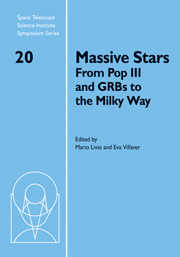Book contents
- Frontmatter
- Contents
- Participants
- Preface
- High-mass star formation by gravitational collapse of massive cores
- Observations of massive-star formation
- Massive-star formation in the Galactic center
- An x-ray tour of massive-star-forming regions with Chandra
- Massive stars: Feedback effects in the local universe
- The initial mass function in clusters
- Massive stars and star clusters in the Antennae galaxies
- On the binarity of Eta Carinae
- Parameters and winds of hot massive stars
- Unraveling the Galaxy to find the first stars
- Optically observable zero-age main-sequence O stars
- Metallicity-dependent Wolf-Rayet winds
- Eruptive mass loss in very massive stars and Population III stars
- From progenitor to afterlife
- Pair-production supernovae: Theory and observation
- Cosmic infrared background and Population III: An overview
Observations of massive-star formation
Published online by Cambridge University Press: 04 August 2010
- Frontmatter
- Contents
- Participants
- Preface
- High-mass star formation by gravitational collapse of massive cores
- Observations of massive-star formation
- Massive-star formation in the Galactic center
- An x-ray tour of massive-star-forming regions with Chandra
- Massive stars: Feedback effects in the local universe
- The initial mass function in clusters
- Massive stars and star clusters in the Antennae galaxies
- On the binarity of Eta Carinae
- Parameters and winds of hot massive stars
- Unraveling the Galaxy to find the first stars
- Optically observable zero-age main-sequence O stars
- Metallicity-dependent Wolf-Rayet winds
- Eruptive mass loss in very massive stars and Population III stars
- From progenitor to afterlife
- Pair-production supernovae: Theory and observation
- Cosmic infrared background and Population III: An overview
Summary
High-mass stars form in deeply embedded cores with very high visual extinction. Such star-forming regions are typically located at distances > 1 kpc from the Sun. Radio interferometric observations are hence vital for studying such regions at spatial resolutions of < 1000 AU. I will review radio observations of high-mass young stellar objects in our Galaxy, with emphasis on recent results from the Submillimeter Array. There now exists a large sample of sources which represent the earliest stages of high-mass star formation. Radio observations of these sources in dust continuum and molecular line emission have shown that they share many characteristics with low-mass star formation. Stars with masses up to ∼20 M⊙ may form via the disk-accretion mechanism instead of merging of lower-mass stars. Several questions regarding masses and stability of such disks still remain outstanding, such as driving mechanisms of the outflows, and multiplicity of sources. Detailed observations of higher-mass stars, which are at > 2 kpc, will be possible with the next generation of radio interferometers, such as the Atacama Large Millimeter Array, which will help address these questions.
Introduction
Massive stars are important due to their role in the creation of heavy nuclei and the chemical enrichment of our Galaxy, and their dynamical effects on the surrounding interstellar medium via stellar winds, photoionization and supernovae shocks, which could even trigger further star formation (Patel et al. 1998).
- Type
- Chapter
- Information
- Massive StarsFrom Pop III and GRBs to the Milky Way, pp. 25 - 39Publisher: Cambridge University PressPrint publication year: 2009



